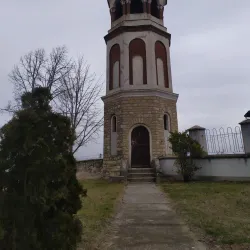
Quality of life in Sveti Nikole
Cost of Living, Healthcare, Safety, Education, and More
Introduction
Sveti Nikole, a charming town in North Macedonia, is known for its rich cultural heritage and vibrant community life. Nestled in the heart of the country, it offers a unique blend of historical significance and modern-day charm. The town is a hub for agriculture, particularly known for its tobacco production, which plays a significant role in the local economy.
In recent years, Sveti Nikole has been experiencing a cultural renaissance, with an increasing number of festivals and events that celebrate its diverse traditions. The town's welcoming atmosphere and scenic landscapes make it an attractive destination for both locals and tourists alike.
History and Culture
Sveti Nikole's history dates back to ancient times, with archaeological findings indicating settlements from the Roman period. The town's name is derived from Saint Nicholas, reflecting its deep-rooted Christian heritage. Over the centuries, Sveti Nikole has been influenced by various cultures, including Byzantine and Ottoman, each leaving a distinct mark on its architectural and cultural landscape.
The town is home to several historical landmarks, such as the Church of Saint Nicholas, which stands as a testament to its religious and cultural history. Sveti Nikole's cultural scene is enriched by local traditions and festivals, such as the annual 'Sveti Nikole Days,' which showcases traditional music, dance, and crafts.
The ethnic diversity of Sveti Nikole contributes to its vibrant cultural tapestry. The town celebrates this diversity through various cultural events that highlight the contributions of different communities to its social fabric. Art and music play a significant role in the town's cultural life, with numerous galleries and music festivals attracting visitors from across the region.
Things to do in Sveti Nikole
Visitors to Sveti Nikole can explore a variety of attractions and activities that highlight the town's cultural and natural beauty. The Church of Saint Nicholas is a must-visit for those interested in history and architecture. For nature enthusiasts, the nearby Ovče Pole region offers stunning landscapes and opportunities for hiking and outdoor activities.
The town hosts several cultural events throughout the year, including the 'Sveti Nikole Days' festival, which features traditional Macedonian music, dance, and cuisine. Local markets offer a taste of the region's agricultural produce, with fresh fruits, vegetables, and tobacco products being popular among visitors.
Sveti Nikole's dining scene is also worth exploring, with local restaurants serving traditional Macedonian dishes that reflect the town's rich culinary heritage. From hearty stews to delicious pastries, there is something to satisfy every palate.
Quality of Life Rankings
Weather in Sveti Nikole
Sveti Nikole, North Macedonia experiences a continental climate characterized by hot summers and cold winters. The city receives an average annual precipitation of approximately 20 inches (500 mm), with May being the wettest month, averaging around 2.5 inches (65 mm) of rainfall.
Seasonal Breakdown
- Spring (March to May)Temperatures gradually rise from an average high of 55°F (13°C) in March to 75°F (24°C) in May. Rainfall increases during this period, with May receiving the most precipitation, averaging 2.5 inches (65 mm).
- Summer (June to August)The hottest months, with average highs ranging from 85°F (29°C) in June to 95°F (35°C) in July. Rainfall decreases during the summer, averaging around 1.5 inches (38 mm) per month.
- Autumn (September to November)Temperatures gradually decrease from an average high of 80°F (27°C) in September to 55°F (13°C) in November. Rainfall remains moderate, averaging around 1.8 inches (45 mm) per month.
- Winter (December to February)The coldest period, with average highs ranging from 45°F (7°C) in December to 40°F (4°C) in February. Snowfall is minimal, averaging about 2 inches (50 mm) in January.
Notable Weather Events
- Occasional heatwaves during the summer months.
- Cold snaps in winter with temperatures dropping below freezing.
- Thunderstorms are more frequent in late spring and early summer.
Sveti Nikole's Political Climate
Sveti Nikole, a city in North Macedonia, is characterized by a dynamic political climate that reflects both its historical roots and contemporary challenges. The city operates under a parliamentary democracy, which is the broader political system of North Macedonia. Local governance in Sveti Nikole is influenced by national politics, with a focus on aligning with the country's European Union accession goals.
Historically, Sveti Nikole has been a center for agricultural development, which continues to influence its political priorities. The city's leadership is often involved in discussions about rural development, economic diversification, and sustainability. Recent political discourse has centered around improving infrastructure and public services, which are crucial for enhancing the quality of life for its residents.
Sveti Nikole has been proactive in implementing progressive policies, particularly in the areas of environmental sustainability and social welfare. The city has initiated several green projects aimed at reducing carbon emissions and promoting renewable energy. Additionally, there are ongoing efforts to improve social justice through community programs and inclusive policies.
The political climate in Sveti Nikole is also shaped by its active civil society. There is a strong tradition of civic engagement, with numerous local organizations advocating for various causes, from environmental protection to human rights. This engagement is reflected in the city's policy-making processes, which often incorporate public input and feedback.
Political Quick Facts
- Voter Turnout65%
- City GovernanceMayor-Council system
- CompositionMajority SDSM with minority representation from VMRO-DPMNE and other local parties
- Recent Political ChangesIncreased focus on EU integration policies and local economic development initiatives
- EngagementHigh, with active participation in local governance and community initiatives
- Political ScorecardB+ for transparency and governance
- Legislative PrioritiesInfrastructure development Environmental sustainability Social welfare enhancement
- Public OpinionGenerally supportive of EU integration and progressive social policies
Notable Political Figures
- Petar RistovskiCurrent Mayor known for his focus on infrastructure and economic development.
- Ana PetrovaCity Council member and advocate for environmental policies.
- Milan StojanovLocal activist and leader in social justice initiatives.









